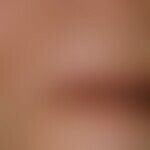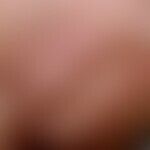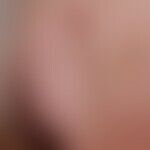HistoryThis section has been translated automatically.
Dieffenbach, 1845
DefinitionThis section has been translated automatically.
The wedge-shaped excision of a lesion is usually performed in three layers, e.g. skin-muscle tissue-mucosa or skin-cartilage-skin.
General informationThis section has been translated automatically.
- Multilayer wedge-shaped excisions can be performed on the lower and upper lip, on the auricle and on the lower eyelid. In the lip area, the defect width must not exceed 2 cm (about half of the lip width) to ensure primary closure without noticeable distortion or reduction of the mouth opening. The labial artery runs from the lip red to the mucous membrane border at the beginning of the last third. Here the artery can be exposed and ligated through a small incision. The lip red border is to be marked with thin holding threads for later identification. At the mucous membrane, the gingival sulcus should not be included in the excision area due to extreme pressure sensitivity of the mucosa. Wound closure in layers begins with the submucosal suture, it avoids penetration of the mucosal epithelium and the absorbable suture does not dissolve prematurely due to saliva exposure. Following adaptation of the muscles, the skin suture is applied, starting at the previously marked lip red border (Fig. 1 a-c).
- If there is a wide defect, the incision can be W-shaped or pentagonal. In the area of the oral mucosa the incision is V-shaped and in the skin area W-shaped (V-W plastic). The orbicularis oris muscle must be partially cut through, which makes reanastomosis necessary. The skin suture is inversely Y-shaped, which reduces the ambient tension (Fig. 2 a-c).
- If the width diameter of the defect is not much more than 1 cm after three-layer wedge excision at the auricle, primary closure is usually successful without the anthelix area bulging (Fig. 3a-c). A defect size of more than ⅓ of the helix edge results in the auricle folding over. In this case, auricular reduction surgery according to Trendelenburg is indicated.
- Keilex incisions on the lower eyelid, where the cranial horizontal incision maintains a minimum distance of 5 mm from the edge of the eyelid, can be treated with a lateral shifting plastic with temporal Burow triangle (Fig. 4 a-c).
LiteratureThis section has been translated automatically.
- Haneke E (1982) Closure of wedge excisions of the lip. J Dermatol Surg Oncol 8: 890-1
- Kaufmann R, Podda M, Landes E (2005) Dermatological operations. Colour atlas and textbook on skin surgery. Thieme, Stuttgart New York
- Knabel M, Koranda FC, Olejko TD (1982) Surgical management of primary carcinomas of the lower lip. J Dermatol Surg Oncol 8: 979-983
- Sebben JE (1985) Wedge resection of the lip: minimizing problems. J Dermatol Surg Oncol 11: 60-64
- Trias AA, Fresdena AC, Semeraro C (1982) Surgical treatment of carcinoma of the lip. J Dermatol Surg Oncol 8: 367-374















